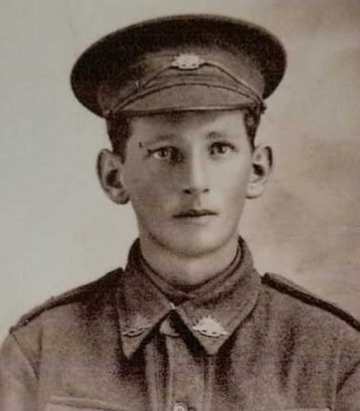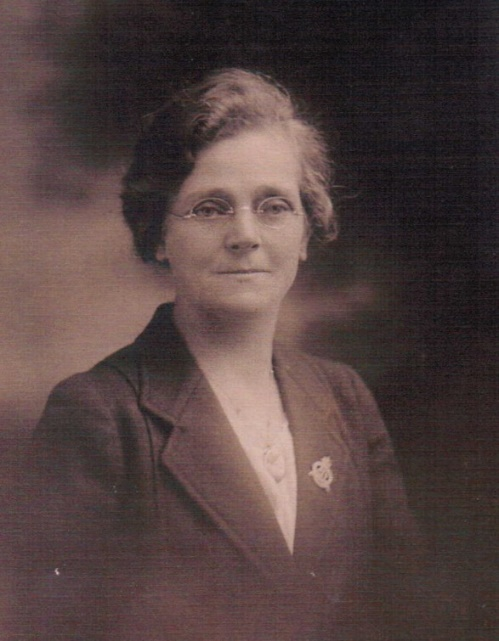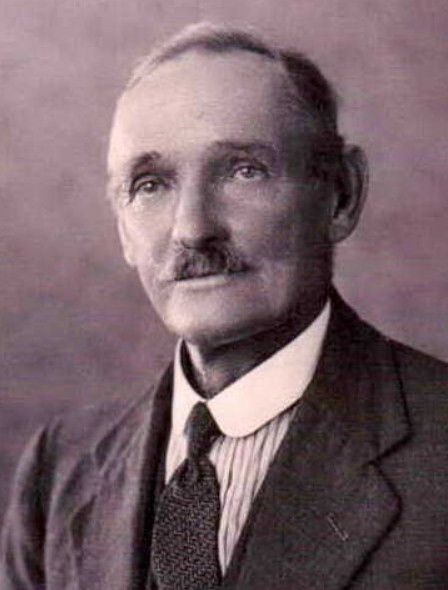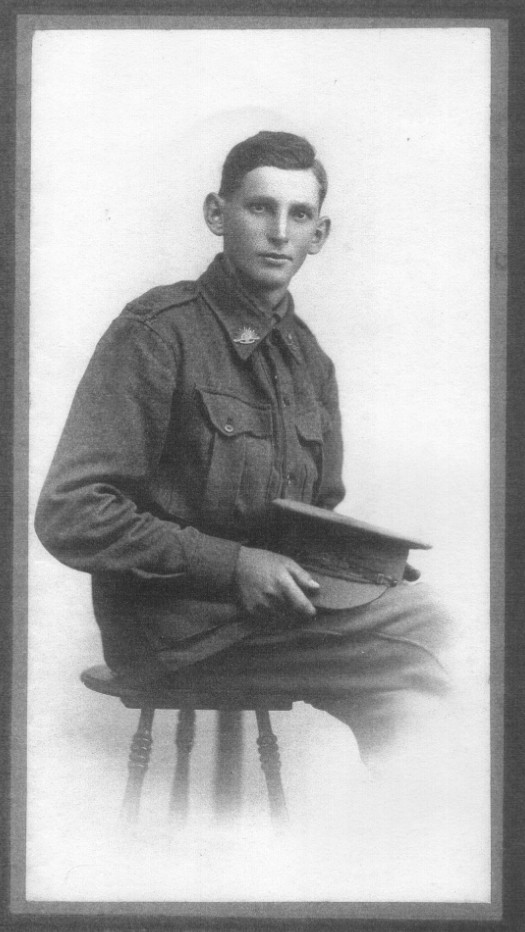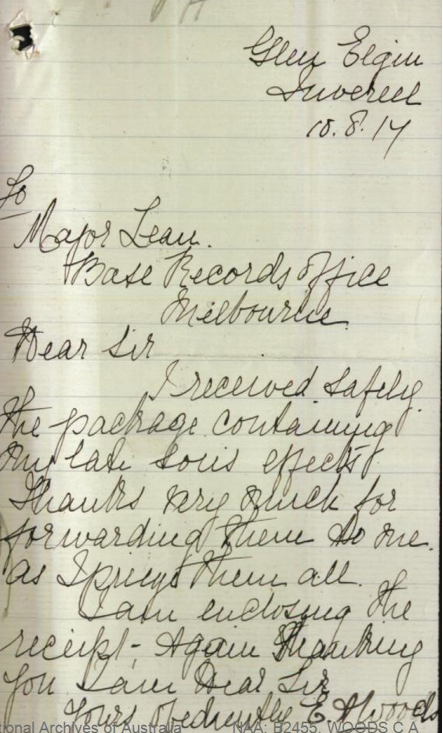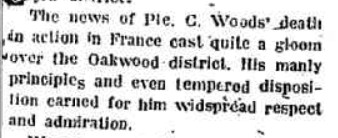Charles Albert WOODS
Eyes brown, Hair fair, Complexion fair
Charles Albert Woods - “Somewhere else in France”
Can you help us identify Charlie?
Charlie was killed in Action at Fromelles. As part of the 3oth Battalion he was positioned near where the Germans collected soldiers who were later buried at Pheasant Wood. There is a chance he might be identified, but we need help. We are still searching for suitable family DNA donors.
In 2008 a mass grave was found at Fromelles, a grave that the Germans dug for 250 (Australian) bodies they recovered after the battle.
Family have come forward to help.
See the DNA box at the end of the story for what we do know about his family.
Life Before the War
Charles Albert Woods, known as "Charlie," was born in 1895 at Meroo Meadow, near Nowra, New South Wales. He was one of a large family born to Alfred Henry Woods (1865-1946) and Emma Ada née Smith, (1868-1952) a dairy farming family. Alfred’s family were descended from a Cheshire ‘Yarwood’ convict while Emma’s family came from Somerset. They had ten children, most born at Meroo Meadow near Nowra, and in 1904, they moved way north to settle at “Glen Elgin”, where Alfred developed an award-winning Ayrshire farm, at Oakwood, outside Inverell —and it is no surprise that Charlie gave his occupation as dairy farmer on enlistment.
He was one of nine children:
- Alice Ada Clinton, 1889-1956 m Alexander Hunt
- May (Maizie), 1890-1969 m Harold Marsh
- Thomas Alfred Sidney, 1891-1902
- Gordon William, 1893-1973 m Dorice Middleton
- Charles Albert, 1894-1916
- Oscar Joseph , 1897-1981 m Dulcie Little
- Gladys Annie, 1898-1992 m Stan McCarthy
- Emma Josephine, 1900-1948
- Robert Henry “Keith”, 1904-1966 m Ada Lloyd
Emma and Alfred Woods, both lived into their 80s. When Alfred died in 1946 and Emma in 1952, their obituaries disclosed much of the Woods family life. In public life Alfred filled positions such as Director of the Butter Factory, Councillor and President of the Bannockburn Shire and Director of the P.P. Board. He was also a valued committee man of the P. & A. Society, where in addition to dairy cattle he exhibited, and raced, trotters. He was one of those genial, easy to get along with souls, whom to know was to like. It sounds as though the children were brought up in an active and busy farming life, first in Nowra and then from 1904 in Inverell.
Mrs. Woods' skill in the culinary arts was in no small way responsible for success at their local show. She had worked tirelessly for many years in the service of others, the Glebe Methodist Mission being one of her chief interests. Her gentle ways endeared her to all who knew her . Charlie attended Inverell Public School, where he was remembered as a diligent and respectful student. His teacher, Mr. H. Denshire, later remarked that Charlie was the sixth pupil from his class to volunteer for service in the Great War — a legacy of local pride and sacrifice. By his early twenties, Charlie was working as a dairy farmer on the family property.
A farewell event was held in his honour at Oakwood Hall in September 1915, where over 200 residents gathered to pay tribute. Local leaders, schoolteachers, and community members spoke of his "manly qualities" and presented him with a fountain pen as a symbol of their admiration and hopes for his safe return. His father, though visibly moved, spoke with great pride:
“Though at first reluctant to part with his son, he was proud to think that he was going to do his share in avenging the blood of innocent women and children.”
His decision to enlist came not from adventure, but from a sense of duty — a theme echoed by his fellow soldiers and remembered by his community long after his death.
War Service
Charlie enlisted in the Australian Imperial Force on 30 August 1915 at Inverell, New South Wales, at the age of 20. He was assigned to the 30th Battalion, 3rd Reinforcements, and after training, embarked from Sydney aboard HMAT A70 Ballarat on 16 February 1916. He wrote from aboard the ship and later from Egypt, recounting parts of his journey:
“We sailed on the Ballarat from Sydney on the 16th February… We went ashore at Colombo — it is a nice town but very hot. Afterwards we disembarked at Suez and went by train through a desert to Zietoun Camp, a distance of 80 miles… Cairo is a very large city and is divided into two quarters, the old or native quarter, and the modern quarter. The native quarter is filthy and degraded, and it is where a lot of our soldiers ruined their lives.”
On 1 April 1916, Charlie was taken on strength with B Company, 30th Battalion at Ferry Post, Egypt. After just over two months in the Middle East, the battalion was sent to the Western Front. Charlie embarked from Alexandria on 16 June 1916 and disembarked at Marseilles, France, on 23 June 1916. By mid-July, the 30th Battalion was positioned in the Fleurbaix sector, near the village of Fromelles. Orders soon came for the battalion to participate in what would become Australia’s most tragic 24 hours on the Western Front.
Letter from the Trenches
The following letter was received by the Woods family just days before confirmation of Charlie’s death and details his last few days in the trenches before the battle:
“Since writing last we have shifted from ‘somewhere in France’ to ‘somewhere else in France,’ and are now in the trenches. Whilst writing this the shells are whistling over our heads a ‘treat.’ We are all provided with steel helmets to lessen the danger of being hit in the head with shrapnel, and also with gas helmets, to put on while a gas attack is being made on us.
The scenery we passed through on the way here was beautiful. I have never seen such an expanse of such beautiful country before. The fields were covered with wheat, and other cereals, and mixed with them were thousands of brilliant scarlet poppies, making a very nice effect. On the hillsides are great vineyards, while scattered here and there, pretty farmhouses nestled amid clumps of big trees.
On arriving at the base a whole lot of letters were given out, and as I had not received any for over six weeks, I expected a big bucket; but I was doomed to disappointment, I got only one, and that was not from home.
Bert and I are in the best of health, and I hope you are all the same at home. A nice feature about this side of the world is the twilight. The sun goes down about 8 o'clock — new time, the clocks having been put on an hour because of the Daylight Saving Scheme, and it does not get dark until after 10 o'clock.
The trenches are over-run with rats. They are nearly as big as cats, and when they fight they make about as much noise as them. We all sleep in dugouts, two men to each dugout, and they have all fancy names, such as ‘Admiralty House’ (which is our platoon commander's abode), ‘Abode of Love,’ the ‘Do Drop In,’ etc.
We have seen a good many attacks on different aeroplanes since we touched this spot.”
—Private Charles A. Woods

Fromelles
Only weeks after arriving in France, the 30th Battalion was thrown into its first major action — the disastrous assault at Fromelles, on 19–20 July 1916. On 19 July, 29 officers and 927 other ranks of the 30th Battalion were committed to the battle. Their initial role was to support the attacking 31st and 32nd Battalions by digging trenches, carrying supplies and ammunition, and reinforcing the line if needed. But the chaos of battle soon drew them directly into the fight. Amid this chaos, Charlie’s fate was sealed.
His close friend, 2036 Private John A. Frisby, who had enlisted and trained alongside him, provided a moving account of his final moments:
“Our men had taken the German trenches and our Company had to dig a trench to connect ours with the captured ones. We advanced out of our trenches, creeping along through shell holes, until we reached the barbed wire, where we had to jump out of a small trench, through the wire entanglements into ‘No Man's Land,’ where we had to dig the trench. Charlie leaped over into the open and had only gone a few yards when a German machinegun sniper caught him in both legs pretty badly. I was third behind him. One of our fellows turned him on his back, and then I came up and spoke to him.”
More accounts were given of Charlie’s fate:
“Charlie leaped over into the open and had only gone a few yards when a German machine-gun sniper caught him in both legs pretty badly… Charlie had just taken out his Bible as I reached him. He gave me his watch and ring to send home to you… They tell me he died just after I left him, reading his Bible, with a perfect faith and trust in Jesus Christ.”
A second letter from his friend Private Archibald W. Addison, also of Inverell, reassured the family:
“He did not suffer much pain, death being almost instantaneous… I found him to be a manly man, a friend, and comrade to be proud of… You may take comfort in the knowledge that your son died as honourably as he lived.”
And finally, Chaplain Rev. F. G. Ward, writing from the field, offered these words:
“It was their first engagement, and they fought wonderfully. He, as others, paid the supreme sacrifice, and now rests from his labours… I pray that God will comfort you in this your sorrow.”
The 30th Battalion were initially assigned a support role at the commencement of the Battle. At 5.53 PM, the 32nd Battalion charged over the parapet, followed by the 31st at 5.58 PM. German machine guns swept the field from emplacements at Delangre Farm and to the left of the attacking waves. Despite the odds, the Australians managed to seize the German front-line trench by 6.30 PM, though it was described as:
“practically a ditch with from 1 to 2 feet of mud and slush at the bottom.”
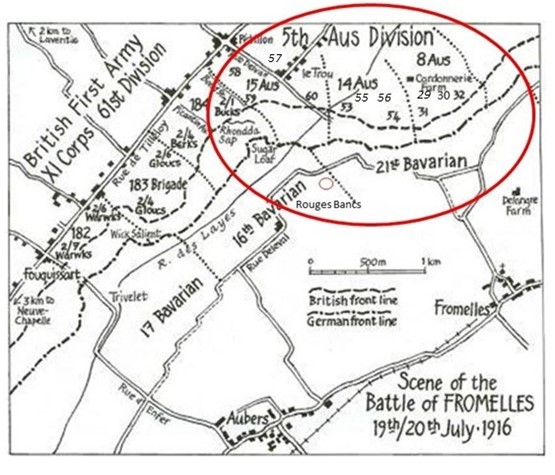
Though the 30th was assigned a support role, commanders on the scene ordered them forward to reinforce the front. This decision — born of necessity — had grave consequences, disrupting the supply chain and costing lives. By 8.30 PM, the Australians’ left flank came under heavy artillery and shrapnel bombardment. Despite their own exhaustion and losses, the 32nd was instructed “the trenches were to be held at all costs.” The 30th was called in formally at 10.10 PM, but their commanding officer, Lieutenant-Colonel Clark, gave a grim report:
“All my men who have gone forward with ammunition have not returned. I have not even one section left.”
Fighting continued through the night. Australian soldiers attempted to push beyond the German first line, but they were low on grenades and under fire from both enemy and friendly artillery. German counterattacks began at 4.00 AM from the left flank and escalated to a full assault at 5.30 AM, when they attacked from both sides with bombing parties. An Australian witness wrote:
“The enemy swarmed in and the retirement across No Mans’ Land resembled shambles, the enemy artillery and machine guns doing deadly damage.”
By 10.00 AM on 20 July, the Germans had fully repelled the assault. The 30th Battalion was withdrawn — badly wounded in a battle they had not even been intended to lead. Despite their original support role, their losses were devastating, 54 killed, 230 wounded, and 68 missing. Ultimately, 125 soldiers of the 30th Battalion were either killed or died of wounds, and 80 remain missing or unidentified.
Years later, Australia’s official war correspondent Charles Bean returned to the battlefield. He noted bones, torn uniforms, and Australian kit still strewn across No-Man’s-Land — grim evidence of what had occurred. As one soldier, Private Jim Cleworth described it:
“The novelty of being a soldier wore off in about five seconds — it was like a bloody butcher’s shop.” — Private Jim Cleworth (784), 29th Battalion
After the Battle
“he died just after I left him, reading his Bible, with a perfect faith and trust in Jesus Christ.”
Charlie was only 21 years old when he was killed in action during the Battle of Fromelles. His body was never recovered from the battlefield, and he has no known grave. He is commemorated at the V.C. Corner Australian Cemetery and Memorial, Fromelles, France, where the names of 1,299 missing Australians are engraved in stone.
His name is also honoured at home, appearing on multiple memorials in Inverell, including:
- Inverell War Memorial
- Inverell & District Memorial Olympic Pool Honour Roll
- Kurrajong Parade Avenue of Honour (Tree No. 165)
- Oakwood Honour Roll
- Australian War Memorial, Panel 118
On 8 September 1916, the Bannockburn Shire Council held a special meeting to express public condolences. The Shire President, Mr. A. S. Pigott, led the motion of sympathy:
“He [Charles] died bravely fighting at the front, and not shirking at home… a soldier’s death was the most noblest of all, and the truest test of character.”
Charlie’s father, Cr. A. H. Woods, who was present, made an emotional response:
“It had been a very hard blow to his wife and himself to bear, but at the same time they felt proud that their boy had done his duty… He would rather see his boy where he was that day than he would see the Germans take possession of their country.”
Charlie’s memory lived on in the words of family and friends, in the community’s tributes, and in the long shadow cast by Australia’s first major battle on the Western Front. Charlie’s mother, Emma Ada Woods, never stopped honouring her son's memory. Over four decades after the war, she wrote to the AIF Base Records Office requesting the Mother’s Badge she never received — a token of recognition for her family’s sacrifice.
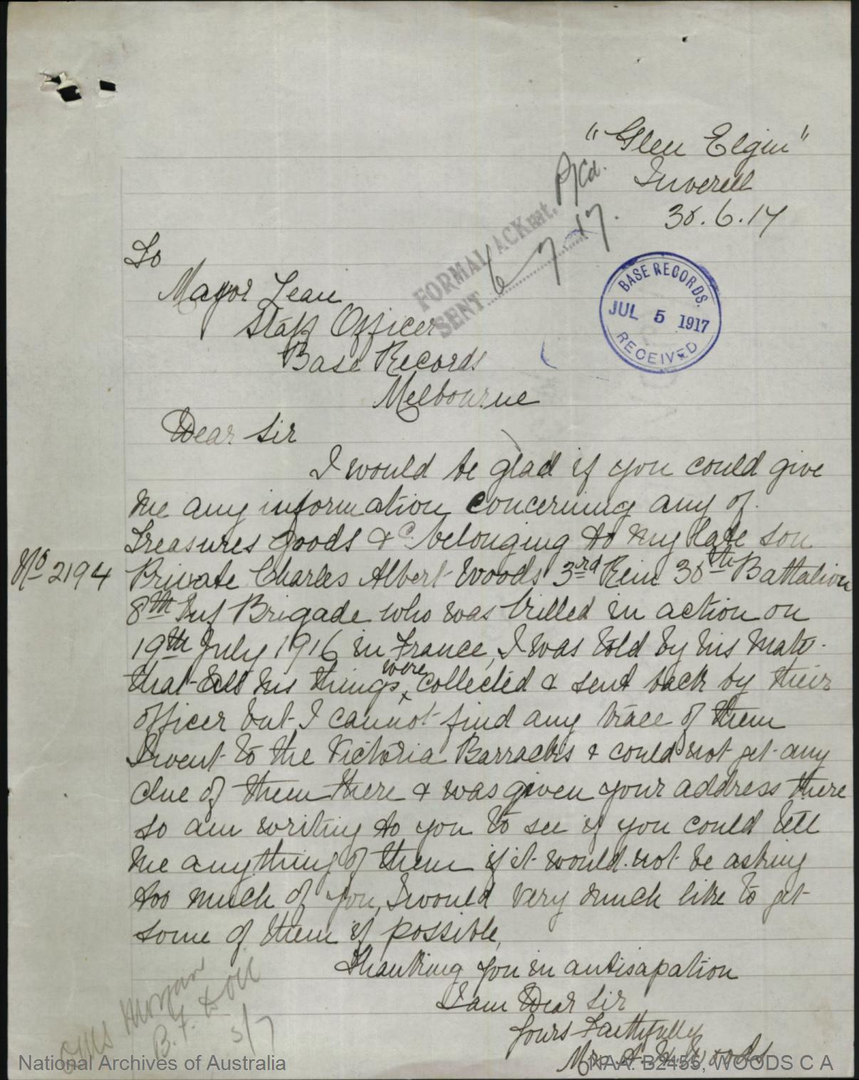
On the first anniversary of his death, Charles’s grieving family published a heartfelt memorial in the Inverell Times:
“He fell, a hero in the deadly strife.
For King and Country he laid down his life.
Fame was achieved, and he had done his share
To win those laurels, rich and rare,
Which now adorn Australia's loyal race.
Not even time its glory can efface.”
— Inserted by his sorrowing Father, Mother, Brothers and Sisters
A Tree for Charlie
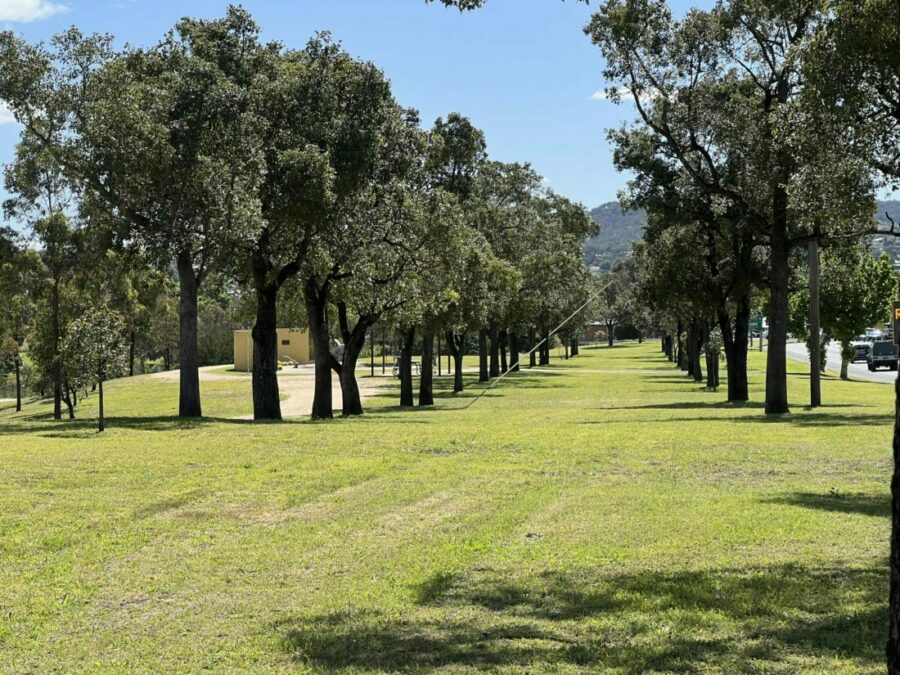
In 1919, the Inverell Municipal Council established the Kurrajong Parade Avenue of Honour — a living memorial to the nearly 200 local men who died in the First World War. Each tree was planted to represent a fallen soldier, with a plaque bearing their name and unit.
Tree No. 165 was planted in memory of Private Charles Albert Woods, 30th Battalion, Killed in Action 20 July 1916
At the dedication, Alderman McIlveen expressed the importance of the avenue for families who could never visit their loved ones' graves in France:
“The trees they were about to plant that day would grow none the less vigorously because many of them would be watered by the tears of the bereaved… May their memory be ever green.”
Charlie’s father, Alfred Henry Woods, also contributed to the Tablet Fund to ensure his son’s name would be honoured with a permanent marker beneath the tree.
Can you help us identify Charlie?
Charlie has no known grave. Like many others killed during the Battle of Fromelles, he may lie among the unidentified soldiers recovered from the mass grave at Pheasant Wood in 2008. These remains were reburied in the Fromelles (Pheasant Wood) Military Cemetery, but over 80 men from the 30th Battalion remain unidentified.
Family have come forward to assist with identification, and DNA samples have been provided. We remain hopeful that ongoing comparisons with the unidentified soldiers at Fromelles will lead to Charlie being formally identified and named.
DNA samples are being sought for family connections to
| Soldier | Charles Albert Woods (1895–1916) |
| Parents | Alfred Henry Woods (1865–1946) & Emma Ada nee Smith (1868–1952) |
| Siblings | Alice Ada Clinton Woods (1889–1956) married Alexander Hunt | ||
| May Catherine Woods (1890–1969) married Harold Marsh | |||
| Thomas Alfred Sidney Woods (1891–1902) | |||
| Gordon William Woods (1893–1973) married Dorice Middleton | |||
| Oscar Joseph Woods (1897–1981) married Dulcie Little | |||
| Gladys Annie Woods (1898–1992) married Stan McCarthy | |||
| Emma Josephine Woods (1900–1948) | |||
| Robert Henry “Keith” Woods (1904–1966) married Ada Lloyd | |||
| Alfred Henry Woods (1911–1999) |
| Grandparents | |||
| Paternal | William James Woods (baptised Yarwood, 1833–1915) & Annie Hannah Keanan (1837–1913) | ||
| Maternal | Robert Smith (1827–1872) & Christian “Catherine” Stephens (1827–1879) |
Links to Official Records
Seeking DNA Donors

Contacts
(Contact: carla@fromelles.info or geoffrey@fromelles.info).
(Contact: army.uwc@defence.gov.au or phone 1800 019 090).
Donations
If you are able, please contribute to the upkeep of this resource.
(Contact: bill@fromelles.info ).
